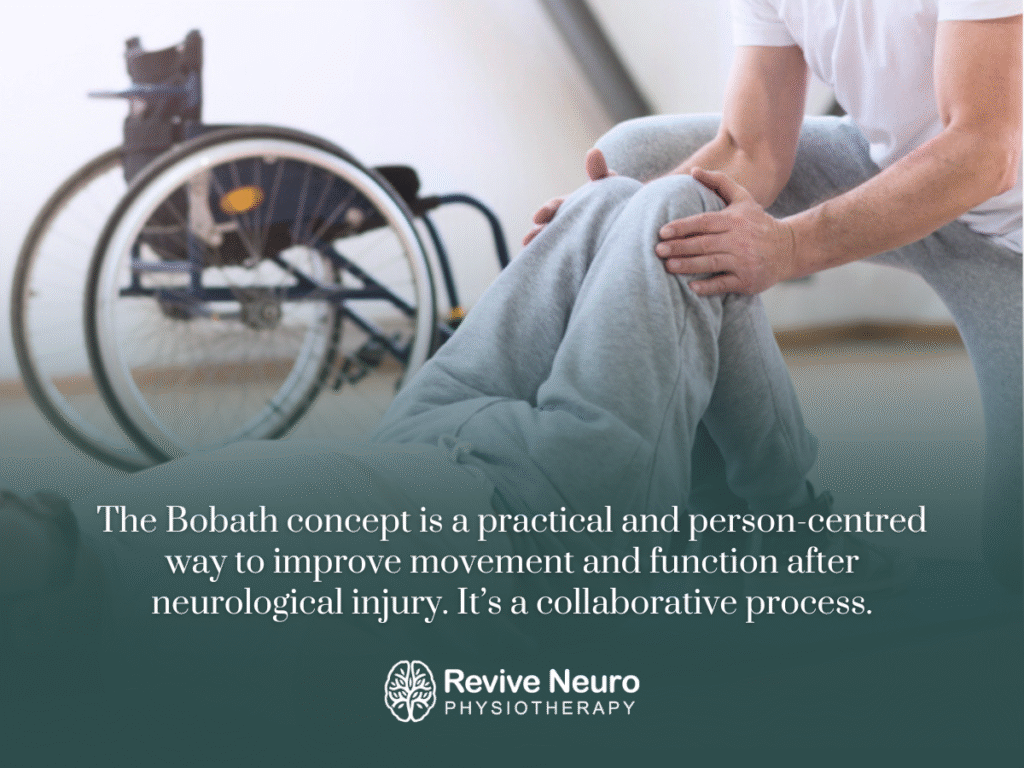If you or a loved one are receiving physiotherapy for a neurological condition such as stroke, brain injury, cerebral palsy, or multiple sclerosis, you may have heard the term Bobath. But what exactly does it mean — and how does it help? In this blog, we break down the Bobath concept and how it supports movement, recovery, and quality of life for people with neurological conditions.
What is the Bobath Concept?
The Bobath concept is a clinical approach to neurological rehabilitation developed by Berta and Karel Bobath in the mid-1900s. It is not a set of fixed exercises or routines — instead, it is a problem-solving and hands-on approach that focuses on improving movement and function in people with damage to the central nervous system (brain or spinal cord).
The Bobath approach looks at the whole person — how they move, how they function, and how their body responds to different positions and environments. It is based on the idea that the brain is capable of change (called neuroplasticity), and with the right support, people can learn or relearn movement patterns.
How Do Neurological Physiotherapists Use Bobath?
Physiotherapists trained in Bobath assess and treat clients by focusing on the whole person. Here’s how:
1. Understanding Movement Patterns
Instead of focusing on a single muscle or joint, Bobath-trained therapists watch how a person moves as a whole. They consider:
- Which movements come easily?
- Which movements are difficult or compensatory?
- How does posture affect balance and coordination?
- Are there patterns of stiffness (spasticity) or floppiness (hypotonia)?
This whole-body observation helps guide treatment in a personalised and meaningful way.
2. Guiding Movement Through Touch
One of the key parts of Bobath therapy is facilitation — using hands-on techniques to help the person feel and experience more normal movement patterns. For example, a therapist might gently guide a person’s hip and shoulder during a sit-to-stand transfer to encourage proper alignment and muscle activation. This helps the brain “relearn” more efficient and safe ways to move.
3. Functional, Everyday Activities
Bobath therapists don’t just train muscles — they work on functional tasks that matter in everyday life. This might include:
- Standing balance for dressing
- Reaching and grasping to prepare food
- Walking safely to improve independence
Therapy is often done in natural, real-world positions and settings, which makes it more relevant and effective.
4. Adapting the Environment
Sometimes, even a small change in a chair, cushion, or support can make a big difference in how someone moves. The Bobath approach considers the environment — including surfaces, posture supports, and mobility aids — to give each person the best chance to succeed in therapy and daily life.

Who Can Benefit from Bobath?
The Bobath concept is commonly used for people with:
- Stroke
- Brain injury
- Spinal cord injury
- Multiple sclerosis
- Parkinson’s disease
- Cerebral palsy
- Other neurological conditions
Whether someone is newly diagnosed or living with long-term disability, Bobath can be adapted to match their goals and abilities.
Why Bobath Still Matters
Although new technologies and treatment approaches have developed over the years, Bobath remains widely used because it:
✅ Focuses on the whole person
✅ Is tailored to individual needs
✅ Encourages active participation
✅ Builds real-life function, not just strength
✅ Supports neuroplasticity and recovery
Many neurological physiotherapists integrate Bobath principles with other evidence-based techniques to create the most effective, person-centred therapy.
Final Thoughts
The Bobath concept is more than a method — it’s a way of thinking and working that helps people with neurological conditions move better, feel more confident, and regain everyday function. At its heart, it’s about creating a partnership between the therapist and the client to achieve meaningful, real-world goals.
If you’d like to learn more about how Bobath-informed physiotherapy can support you or someone you care about, our neuro physio team is here to help. Every session is guided by experience, compassion, and a belief in your potential for progress.



